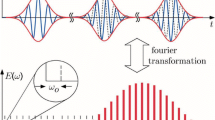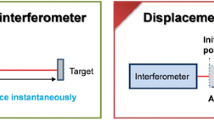Abstract
Here, we present a novel technique for time resolved experiments without any moveable external delay line. Optical Sampling by Cavity Tuning (OSCAT) method is based on a femtosecond laser with a tunable repetition rate and a passive delay line. The time delay between the pump and probe pulses is determined by the repetition rate of the femtosecond laser.






Similar content being viewed by others
References
A. H. Zewail, “Femtochemistry: Atomi-Scale Dynamics of the Chemical Bond,” J. Phys. Chem. A 104, 5660–5694 (2000).
V. Sundström, “Femtobiology,” Annu. Rev. Phys. Chem. 59, 53–77 (2008).
J. Shah, Ultrafast Spectroscopy of Semiconductors and Semiconductor Nanostructures, 2nd Edition (Springer, Berlin, 1999).
S. T. Cundiff, “Coherent spectroscopy of semiconductors,” Opt. Express 16, 4639–4664 (2008).
S. Hunsche, D. M. Mittleman, M. Koch, and M. C. Nuss, “New Dimensions in T-Ray Imaging,” IEICE Trans. Electron. E81-C, 269–276 (1998).
N. C. J. van der Valk, W. A. M. van der Marel, and P. C. M. Planken, “Terahertz polarization imaging,” Opt. Lett. 30, 2802–2804 (2005).
M. R. Hee, J. A. Izatt, J. M. Jacobson, J. G. Fujimoto, and E. A. Swanson, “Femtosecond transillumination optical coherence tomography,” Opt. Letters. 18, 950–952 (1993).
R. L. Fork and F. A. Beisser, “Real-time intensity autocorrelation interferometer,” Appl. Opt. 17, 3534–3535 (1978).
K. F. Kwong, D. Yankelevich, K. C. Chu, J. P. Heritage, and A. Dienes, “400-Hz mechanical scanning optical delay line,” Opt. Lett. 18, 558–560 (1993).
X. Liu, M. J. Cobb, and X. Li, “Rapid scanning all-reflective optical delay line for real-time optical coherence tomograhphy,” Opt. Lett. 29, 80–82 (2004).
P.-L. Hsiung, X. Li, C. Chudoba, I. Hartl, T. H. Ko, and J. G. Fujimoto, “High-speed path-length scanning with a multiple-pass cavity delay line,” Appl. Opt. 42, 640–648 (2003).
J. Xu, Z. Lu, and X.-C. Zhang, “Compact involute optical delay line,” Electr. Lett. 40, 1218–1219 (2004).
P. A. Elzinga, R. J. Kneisler, F. E. Lytle, Y. Jiang, G. B. King, and N. M. Laurendeau, “Pump/probe method for fast analysis of visible spectral signatures utilizing asynchronous optical sampling,” Appl. Opt. 26, 4303–4309 (1987).
T. Hochrein, R. Wilk, M. Mei, R. Holzwarth, N. Krumbholz, and M. Koch, “ Optical sampling by laser cavity tuning,“ Opt. Express 18, 1613–1617 (2010).
Y.Yamaoka, K. Minoshima, and H. Matsumoto, “Direct measurement of the group refractive index of air with interferometry between adjacent femtosecond pulses,” Appl. Opt. 41, 4318–4324 (2002).
J. Ye, “Absolute measurement of a long, arbitrary distance to less than an optical fringe,” Opt. Lett. 29, 1153–1155 (2004)
T. Udem, R. Holzwarth, and T. W. Hänsch „Optical frequency metrology“,Nature 416, 233-237 (2002)
Menlo Systems GmbH, http://www.menlosystems.com
Author information
Authors and Affiliations
Corresponding author
Rights and permissions
About this article
Cite this article
Wilk, R., Hochrein, T., Koch, M. et al. OSCAT: Novel Technique for Time-Resolved Experiments Without Moveable Optical Delay Lines. J Infrared Milli Terahz Waves 32, 596–602 (2011). https://doi.org/10.1007/s10762-010-9670-8
Received:
Accepted:
Published:
Issue Date:
DOI: https://doi.org/10.1007/s10762-010-9670-8




